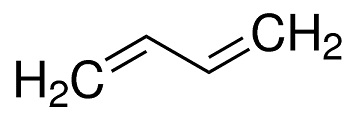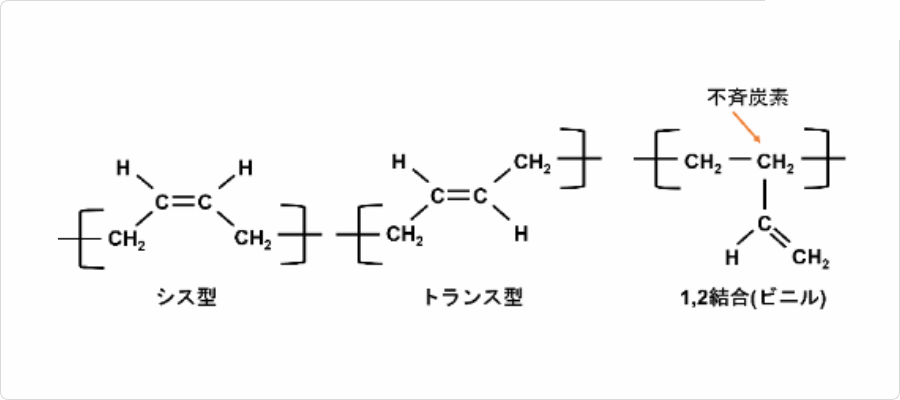-
外観
無色~ほとんど無色透明液体
-
歴史
ジエン(炭素間二重結合を2個もつ化合物の総称)のもっとも簡単なもの。炭素4個からなる直鎖でしかも2個の不飽和結合を含む炭化水素。不飽和結合のある位置により1,2-ブタジエンと1,3-ブタジエンの2種の異性体がある。前者はメチルアレンともよばれ、通常、ブタジエンというと後者をさす。ゴムはイソプレン(2-メチルブタジエン)が重合した構造をもつので、1920年代末にドイツでブタジエンを原料として合成ゴムのブナ(BUNA)が発明された。これを契機としてブタジエンの製造技術の開発が進んだ。さらに太平洋戦争初期に日本が東南アジアを占領してアメリカへの天然ゴムの供給を断ったことが、アメリカにおける合成ゴムの開発を促進したといわれる。現在では、ブタジエンは石油から製造されている。ナフサの分解でエチレンを製造する際に生ずる炭素数4個の留分から得るか、あるいはブタンまたはブテンの脱水素により製造する。可燃性で、常温では無色有毒の麻酔性のある気体であるが、圧力を加えると容易に液化する。日本では年間約100万トン生産されているが、おもに合成ゴムの原料として利用される。これとスチレンとの共重合体はスチレン・ブタジエンゴム(SBR)で汎用(はんよう)合成ゴムとして、またアクリロニトリルとの共重合体(NBR)は耐油性の合成ゴムとして、アクリロニトリルおよびスチレンの双方との共重合体(ABS)は耐衝撃性の合成樹脂として利用される。また、ブタジエンの重合体のポリブタジエン(PBR)も汎用の合成ゴムとして用いられる。[徳丸克己]
-
解説
弱い芳香性を有する引火性の液化しやすい無色の気体.融点-108.92 ℃,沸点-4.41 ℃.爆発範囲2.0~11.5体積%.エタノール,エーテルに可溶,水に不溶.共役した二重結合をもつために化学反応性は高く,とくに重合活性が高いため,貯蔵には重合防止剤および酸化防止剤の添加が必要である.石油化学の重要な原料の一つである.おもにスチレン-ブタジエンゴム(SBR),アクリロニトリル-ブタジエンゴム(NBR),ブタジエンゴムなどの合成ゴム,ABS樹脂(アクリロニトリル-ブタジエン-スチレン共重合樹脂)などの樹脂の原料となる.ほかにクロロプレン,アジポニトリル,1,4-ブタンジオールなどの合成原料としても用いられる.
スチレンブタジエンゴム(SBR),ブタジエンゴム(BR)合成ゴムラテックス合成原料、スチレンブタジエンアクリロニトリル(ABS)樹脂、スチレンブタジエンメタクリレート(MBS)樹脂合成原料、化成品原料、合成ゴム(SBR,NBRなど)の原料森北出版「化学辞典(第2版)
-
用途
ポリブタジエン(BR),スチレン-ブタジエンゴム(SBR),ニトリルゴム(NBR),ポリクロロプレンといった合成ゴムや,アクリロニトリル-ブタジエン-スチレン樹脂(ABS樹脂)などの合成樹脂の原料
-
製造法
C4H6(54.09).CH2=CH-CH=CH2.二重結合の位置により,1,3-ブタジエンと1,2-ブタジエンの2種類の異性体が存在するが,工業的には前者のほうがはるかに重要なので,単にブタジエンという場合は,1,3-ブタジエンをさす.ブタジエンは,二重結合2個をもつ不飽和炭化水素で,通常1,3-ブタジエン CH2=CHCH=CH2 を意味する。無色,無臭,引火性のガス。沸点-4.41℃。石油留分を熱分解してエチレンを製造する際の生成ガスから分離する方法や,ブタンやブテンの脱水素法などにより工業的に大量製造され,合成ゴム製造原料に用いられる。このほかに異性体として1, 2-ブタジエン CH2=C=CHCH3 がある。石油系炭化水素の分解ガス中に存在する.従来,n-ブタンおよびn-ブテン類の脱水素により製造されており,アメリカでは現在でも行われているが,わが国ではナフサ分解によるエテンの生産が大規模に行われ,そこで副生するB-B留分より抽出蒸留で分離精製する方法に完全に転換されている.構造は,共役二重結合を有するもっとも簡単なオレフィンである.原子間距離C=C 0.137 nm,C-C 0.147 nm と二重結合間隔はエテンの場合より長く,C-Cはブタンの場合より短い.このことはブタジエンの共鳴状態に対する一つの論拠となっている.また,C-C結合における分子内回転より,シス形構造とトランス形構造が考えられ,後者のほうが約17 kJ mol-1 安定である.
-
説明
1,3-Butadiene is a simple conjugated diene. It is a colourless gas with a mild aromatic or gasoline-like odour and incompatible with phenol, chlorine dioxide, copper, and crotonaldehyde. The gas is heavier than air and may travel along the ground; distant ignition is possible. It is an important industrial chemical used as a monomer in the production of synthetic rubber. Most butadiene is polymerised to produce synthetic rubber. While polybutadiene itself is a very soft, almost liquid, material, polymers prepared from mixtures of butadiene with styrene or acrylonitrile, such as ABS, are both tough and elastic. Styrene–butadiene rubber is the material most commonly used for the production of automobile tyres. Smaller amounts of butadiene are used to make nylon via the intermediate adiponitrile, other synthetic rubber materials such as chloroprene, and the solvent sulpholane. Butadiene is used in the industrial production of cyclododecatriene via a trimerisation reaction.

1,3-Butadiene structure
-
化学的特性
Butadiene is a gas, b.p. -4°C.
-
物理的性質
Colorless gas with a mild, aromatic or gasoline-like odor. Experimentally determined detection
and recognition odor threshold concentrations were 1.0 mg/m3 (0.45 ppmv) and 2.4 mg/m3 (1.1
ppmv), respectively (Hellman and Small, 1974).
-
使用
Synthetic elastomers (styrene-butadiene, polybutadiene, neoprene, nitriles), ABS resins, chemical intermediate.
1,3-Butadiene can undergo a four-component coupling reaction with aryl Grignard reagents, and alkyl fluorides in the presence of nickel catalyst to form 1,6-octadiene carbon compound substituted with alkyl and aryl groups at the 3- and 8-positions.
1,3-Butadiene is a useful diene for Diels Alder reaction.
It may be used in the synthesis of the following:
- 1-Silyl-substituted 1,3-butadienes, by [RuHCl(CO)(PCy3)2]-catalyzed silylative coupling of terminal (E)-1,3-dienes with vinylsilanes.
- Synthetic rubber and thermoplastic resins.
- Disilylated dimers by reacting with chlorosilanes.
- Octa-2,7-dien-1-ol via palladium catalyzed-hydrodimerization.
-
定義
ChEBI: 1,3-Butadiene is a butadiene with unsaturation at positions 1 and 3. It is a chemical made from the processing of petroleum. About 75% of the manufactured 1,3-butadiene is used to make synthetic rubber. Synthetic rubber is widely used for tires on cars and trucks.
-
製造方法
Butadiene is obtained when n-butenes are dehydrogenated:
n-Butenes are mostly obtained from the catalytic cracking operations carried
out on various petroleum fractions; thermal cracking processes usually give
low yields of butenes. The dehydrogenation of n-butenes is carried out by
mixing the feed with steam (which lowers the partial pressures of the
reactants) and passing over a catalyst such as mixed calcium/nickel phos�phate stabilized with chromium oxide at about 650??C.
-
調製方法
Except for a small amount of butadiene produced by the
oxydehydrogenation of n-butane, most of butadiene is produced
commercially as a by-product of ethylene production
during the steam cracking of hydrocarbon streams. It is
separated and purificated from other components by extractive
distillation, using acetonitrile and dimethylformamide as
solvents.
-
一般的な説明
1,3-Butadiene is a colorless gas with a mild, aromatic, gasoline-like odor. It is shipped as a liquefied gas under its vapor pressure. Contact with the liquid can cause frostbite. It is easily ignited. Its vapors are heavier than air and a flame can flash back to the source of leak very easily. It can asphyxiate by the displacement of air. It must be shipped inhibited as butadiene is liable to polymerization. If polymerization occurs in the container, It may violently rupture. Under prolonged exposure to fire or intense heat the containers may rupture violently and rocket. It is used to make synthetic rubber and plastics, and to make other chemicals.
-
空気と水の反応
Highly flammable. In contact with air, butadiene may form violently explosive peroxides, which can be exploded by mild heat or shock. Solid butadiene absorbs enough oxygen at sub atmospheric pressures to make 1,3-BUTADIENE explode violently when heated just above its melting point [Ind. Eng. Chem. 51:733 1959].
-
反応プロフィール
A colorless gas, 1,3-BUTADIENE can react with oxidizing reagents. Upon long exposure to air 1,3-BUTADIENE forms explosive peroxides. They are sensitive to heat or shock; sudden polymerization may occur [Scott, D. A., Chem. Eng. News, 1940, 18, p.404]. Butadiene polyperoxides are insoluble in liquefied butadiene (m. p. -113° C, b. p. -2.6° C) and progressively separate leading to local concentration build up. Self-heating from a spontaneous decomposition will lead to explosion [Hendry, D. G. et al., Ind. Eng. Chem., 1968, 7, p. 136, 1145]. Explodes on contact with aluminum tetrahydroborate, potentially explosive reaction with chlorine dioxide (peroxide) and crotonaldehyde (above 180° C). Reaction with sodium nitrite forms a spontaneously flammable product [Sax, 9th ed., 1996, p. 539].
-
危険性
A confirmed carcinogen. Irritant in high
concentration. Highly flammable gas or liquid,
explosive limits in air 2–11%. May form explosive
peroxides on exposure to air. Must be kept inhibited
during storage and shipment. Inhibitors often used
are di-n-butylamine or phenyl-β-naphthylamine.
Storage is usually under pressure or in insulated
tanks <35F (<1.67C).
-
健康ハザード
The toxicity of 1,3-butadiene has been foundto be very low in humans and animals. It isan asphyxiant. In humans, low toxic effectsmay be observed at exposure to 2000 ppmfor 7 hours. The symptoms may be hallucinations,distorted perception, and irritation ofeyes, nose, and throat. Higher concentrationsmay result in drowsiness, lightheadedness,and narcosis. High dosages of 1,3-butadienewas toxic to animals by inhalation and skincontact. General anesthetic effects and respiratorydepression were noted. Concentrationsof 25–30% may be lethal to rats and rabbits.Contact with the liquefied gas can cause burnand frostbite.
Exposure to 1,3-butadiene caused cancersin the stomach, lungs, and blood in ratsand mice. It is suspected to be a humancarcinogen. It is a mutagen and a teratogen.
-
火災危険
Behavior in Fire: Vapors heavier than air and may travel a considerable distance to a source of ignition and flashback. Containers may explode in a fire due to polymerization.
-
使用用途
ブタジエン(1,3-ブタジエン)は石油から製造されており、製造法としてはナフサのクラッキングで副生するC4留分から抽出、精製して製造する抽出法と、ブタンやから脱水素して製造する脱水素法があります。
ブタジエンは主に合成ゴムの原料として用いられています。例えば自動車のタイヤなどに使われるスチレン・ブタジエンゴム(SBR)やブタジエンゴム(BR)などの原料にブタジエンが使われています。その他、ブタジエンはABS樹脂やナイロン66の原料にも使われています。
-
構造異性体
1,3-ブタジエンは上記の通りブタジエンゴムなどの原料として使われます。ゴムはブタジエンの重合反応によって得られますが、ブタジエンは反応部位である二重結合が分子内に2つあるため、反応後のシス型とトランス型の割合が製造条件によって変わります。また、この他にも側鎖にビニル基が生成する1,2結合も重合によって形成されます。

ブタジエンの構造異性体
上記の構造異性体の割合は重合方法を変えることで変化させることが可能で、メーカーによって様々なブタジエンゴムが販売されています。シス型が多い高シスタイプのブタジエンゴムは樹脂全体の中でもガラス転移温度が低く(-105~-95℃)、低温特性に優れます。主な用途は自動車タイヤで、その他にOリングやなどにも使われています。低シスタイプは高シスタイプ同様に、ブタジエンゴムも自動車タイヤなどに使われているほか、樹脂の改質剤などにも使われています。
-
安全性と法規制
ブタジエンは常温で気体の物質で、一般的には液化ガスとしてボンベに充填されて販売されています。ブタジエンは可燃性、引火性が極めて高いガスであり、取り扱い時は着火源となるものを取り除くこと、十分に換気された環境で取り扱うことが求められます。また、ブタジエンは重合反応を引き起こしやすいため、貯蔵時は重合防止剤、酸化防止剤の添加が必要です。
その他、ブタジエンは労働安全衛生法上のリスクアセスメント対象物質であり、変異原性が認められた物質でもあります。その他、PRTR法の特定第1種指定化学物質、高圧ガス保安法上の液化ガスにも該当します。
参考文献
-
化学性质
ほとんど生成しないが,熱分解プロセスでは比較的多量に生成する。
-
材料の用途
1,3-Butadiene is noncorrosive and may be used
with any common metals. Steel is recommended
for tanks and piping in butadiene service by
some authorities. If used with plastics, compatibility
must be confirmed. Welded rather than
threaded connections are similarly recommended
because 1,3-butadiene tends to leak
through even extremely small openings. If
threaded connections are used, Schedule 80
pipe should be used. Before being exposed to
1,3-butadiene that is not inhibited, iron surfaces
should be treated with an appropriate reducing
agent such as sodium nitrite because polymerization
is accelerated by oxygen (even if present
as in ferrous oxide), as well as by heat.
-
安全性プロファイル
Confirmed carcinogen
with experimental carcinogenic and
neoplastigenic data. An experimental
teratogen. Mutation data reported.
Inhalation of high concentrations can cause
unconsciousness and death. Human
systemic effects by inhalation: cough,
hallucinations, dstorted perceptions,
changes in the visual field and other
-
発がん性
1,3-Butadiene is known to be a human carcinogen based on sufficient evidence of carcinogenicity from studies in humans, including epidemiological and mechanistic studies. 1,3-Butadiene was first listed in the Fifth Annual Report on Carcinogens in 1989 as reasonably anticipated to be a human carcinogen based on sufficient evidence of carcinogenicity from studies in experimental animals. The listing was revised to known to be a human carcinogen in the Ninth Report on Carcinogens in 2000.
-
環境運命予測
Surface Water. The estimated volatilization half-life of 1,3-butadiene in a model river 1 m deep,
flowing 1 m/sec and a wind speed of 3 m/sec is 3.8 h (Lyman et al., 1982).
Photolytic. The following rate constants were reported for the reaction of 1,3-butadiene and OH
radicals in the atmosphere: 6.9 x 10-11 cm3/molecule·sec (Atkinson et al., 1979) and 6.7 x 10-11
cm3/molecule·sec (Sablji? and Güsten, 1990). Atkinson and Carter (1984) reported a rate constant
of 6.7–8.4 x 10-11 cm3/molecule·sec for the reaction of 1,3-butadiene and ozone in the atmosphere.
Photooxidation reaction rate constants of 2.13 x 10-13 and 7.50 x 10-18 cm3/molecule·sec were
reported for the reaction of 1,3-butadiene and NO3 (Benter and Schindler, 1988; Sablji? and
Güsten, 1990). The half-life in air for the reaction of 1,3-butadiene and NO3 radicals is 15 h
(Atkinson et al., 1984a).
Chemical/Physical. Will polymerize in the presence of oxygen if no inhibitor is present
(Hawley, 1981).
-
貯蔵
1,3-Butadiene is stored in a cool and wellventilatedlocation separated from combustibleand oxidizing substances. Smallamounts of stabilizers, such as o-dihydroxybenzene,p-tert-butylcatechol, or aliphaticmercaptans, are added to prevent its polymerizationor peroxides formation. The cylindersare stored vertically and protected againstphysical damage.
-
合成方法
ナフサ分解のC4留分から得られる。抽出溶剤を用いた抽出蒸留法により分離される。エチレンをナフサ分解以外から得ている地域では,ブテンの脱水素,n-ブタンの2段脱水素を行う。また,エタノール脱水素により得られるアセトアルデヒドとエタノールの脱水反応によるブタジエン製造も行われている。
-
廃棄物の処理
Disposal of l,3-butadiene by venting, incineration,
using a suitable flare system, or by other
means may be subject to permitting by federal,
state, provincial, or local regulations. Persons
involved with disposal of 1,3-butadiene should
check with the environmental authorities having
jurisdiction to determine the applicability of
permitting regulations to disposal activities.






